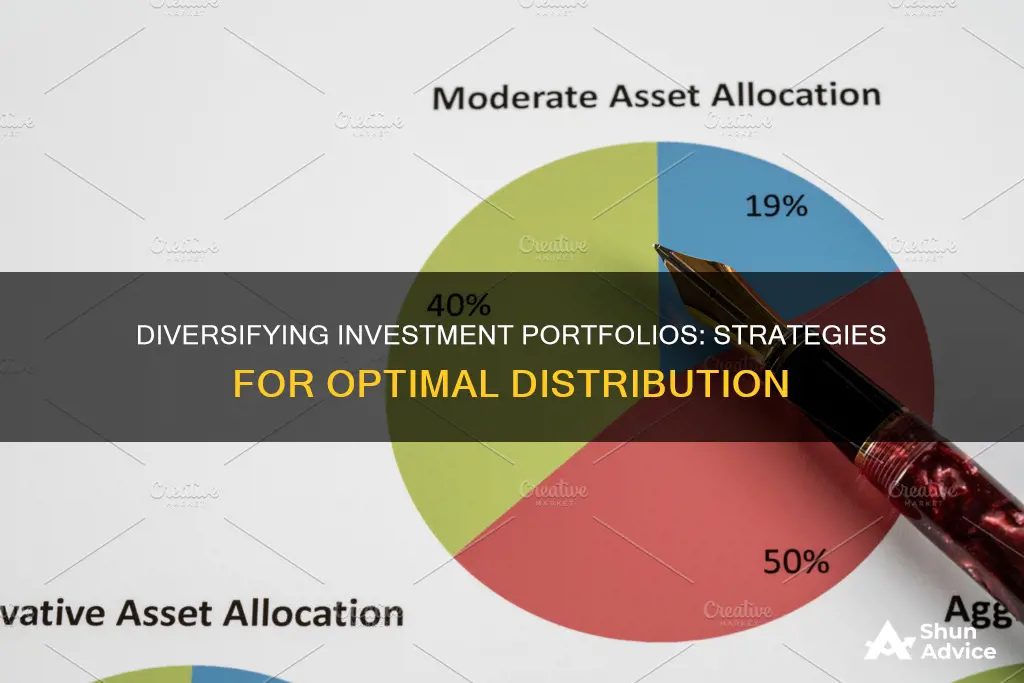
Diversifying your investment portfolio is a crucial strategy to protect your finances and maximise returns. The basic principle is simple: don't put all your eggs in one basket. In practice, this means investing in a variety of asset classes, such as stocks, bonds, real estate, international securities, and cash.
Diversification is a way to manage risk. By spreading your investments across different industries, countries, and risk profiles, you reduce the chances of losing all your assets if a particular market or sector takes a hit. It also helps to stabilise returns, as some investments will counteract losses in others.
There are several ways to diversify your portfolio. You can invest in a range of stocks from different industries, countries, and company sizes (large-cap, small-cap). You can also include fixed-income assets like bonds, which will reduce volatility and risk. Additionally, consider investing in real estate, either directly or through Real Estate Investment Trusts (REITs), which can increase returns and further reduce volatility.
It's also important to periodically rebalance your portfolio to maintain the appropriate weight for each investment. This typically doesn't need to be done more than quarterly, but you should check on it at least twice a year.
While diversification is essential, it's possible to overdo it. Adding too many overlapping investments or funds with high fees can dilute the benefits of diversification. The key is to hold uncorrelated assets, or assets that move in opposite directions, to smooth out the inevitable bumps in the market.
| Characteristics | Values |
|---|---|
| Number of investments | At least 25 |
| Investment types | Stocks, bonds, real estate, international securities, cash, commodities, cryptocurrencies |
| Risk profiles | High-risk, high-return vs. stable, lower returns |
| Investor age | Younger investors can take more risk, older investors should be more cautious |
| Investor finances | Investors with family expenses or more financial responsibilities should be more cautious |
| Investor knowledge | Understand the factors that influence financial markets, including interest rates, inflation, and central bank policies |
| Investor goals | Consider life goals and milestones when reviewing and rebalancing your portfolio |
| Investor biases | Be aware of how external factors like cultural beliefs and family attitudes might influence your decisions |
What You'll Learn
- Diversify your investments across different industries, sectors, and asset classes
- Consider your age and risk tolerance when allocating between stocks and bonds
- Include a mix of domestic and international securities
- Don't forget about cash and cash equivalents for liquidity and stability
- Periodically rebalance your portfolio to maintain your desired allocation

Diversify your investments across different industries, sectors, and asset classes
Diversifying your investments across different industries, sectors, and asset classes is a crucial part of managing your investment portfolio. Here are some detailed tips to help you achieve effective diversification:
Understand the Basics of Diversification:
Diversification is a risk management strategy that involves spreading your investments across various assets, sectors, and industries. By not putting all your eggs in one basket, you reduce the potential loss if a particular investment or sector underperforms. Diversification aims to lower the risk of market volatility while potentially increasing long-term returns.
Diversify Across Asset Classes:
The three main asset classes are stocks, bonds, and cash. Stocks offer high long-term gains but come with volatility. Bonds provide more stable and modest returns. Cash, while offering low returns and low risk, can serve as a buffer during market downturns and provide funds for future investment opportunities. Diversifying across these asset classes is essential to balance risk and return.
Explore Different Industries and Sectors:
Investing in various industries and sectors is crucial for effective diversification. For example, during the Great Recession of 2007-2009, the real estate and financial industries suffered significant losses, while utilities and healthcare remained relatively stable. By investing in a range of industries, you reduce the impact of sector-specific risks.
Consider Company Size and Lifecycle Stage:
Diversifying between large-cap and small-cap stocks is important. Large-cap companies tend to be more stable and established, while small-cap stocks offer higher risk and higher growth potential. Additionally, consider the corporate lifecycle stage—growth stocks have higher risk but higher growth potential, while value stocks are more established and carry less risk.
Go Global with Your Investments:
Don't limit yourself to domestic investments. Explore international markets, including developed and emerging countries. For example, investing in Japanese equities and Australian bonds can provide diversification benefits and potentially higher returns. However, be mindful of the different monetary regulations and dynamics of global markets.
Utilise Mutual Funds and ETFs:
Mutual funds and exchange-traded funds (ETFs) offer an easy and cost-effective way to achieve diversification. These funds allow you to invest in a basket of securities, providing exposure to different asset classes, industries, and sectors. They are particularly useful for investing in narrow markets, such as commodities and international plays.
Remember, the key to successful diversification is to ensure your portfolio has a mix of assets that are not perfectly correlated. This way, you benefit from the positive performance of some investments, which can neutralise the negative performance of others. While diversification may limit short-term gains, it provides long-term stability and reduces overall risk.
Savings and Investments: Two Sides of the Same Coin
You may want to see also

Consider your age and risk tolerance when allocating between stocks and bonds
When it comes to distributing your investment portfolio, age and risk tolerance are key factors to consider when allocating between stocks and bonds. Here are some detailed insights to guide your investment decisions:
Firstly, it's important to understand the characteristics of stocks and bonds. Stocks are typically associated with higher risk and higher potential returns. They offer the greatest growth potential and are suitable for long-term financial goals. On the other hand, bonds are considered less risky and provide steadier returns. They are a good option for those seeking stable income and lower volatility.
As a general rule of thumb, younger investors tend to have a higher risk tolerance and a longer investment horizon. This allows them to allocate a larger portion of their portfolio to stocks. The formula often used is to subtract your age from 100 to determine the percentage of stocks in your portfolio. For example, a 30-year-old may allocate 70% to stocks and 30% to bonds. However, it's important to note that this rule has evolved, and some experts now suggest subtracting your age from 110 or 120 to maintain a more aggressive stock allocation.
As you approach your 50s, it's advisable to reevaluate your portfolio. You may want to adjust your allocation to 60% stocks and 40% bonds, depending on your risk tolerance. If market volatility makes you anxious, consider reducing your stock allocation and increasing your bond holdings. This shift towards a more conservative approach becomes more pronounced as you enter retirement age, where a 50/50 split between stocks and bonds is common.
It's crucial to remember that everyone's risk tolerance and financial circumstances are unique. While age is a significant factor, it's not the only consideration. Your innate risk tolerance plays a vital role in determining your ideal asset allocation. If you're younger but risk-averse, a 50/50 split between stocks and bonds may help you sleep better at night. Conversely, if you're older but comfortable with risk, you may opt for a higher stock allocation.
Additionally, it's important to periodically review and rebalance your portfolio. As you age, your financial obligations, goals, and risk appetite may change. By regularly assessing your investments, you can ensure they remain aligned with your current circumstances and make adjustments as necessary.
Maximizing Small Savings: Smart Strategies for Investing Wisely
You may want to see also

Include a mix of domestic and international securities
Diversifying your investment portfolio is a crucial step in minimising risk and maximising returns. While the basic types of investments are stocks and bonds, it is also important to diversify within each class of security. This means investing in different industries, interest plans, and tenures. For instance, rather than putting all your investments in the pharmaceuticals sector, spread your investments across other sectors like education technology or information technology.
Similarly, diversifying your portfolio by including a mix of domestic and international securities can help to further reduce risk and smooth out returns. This strategy is based on the fact that markets outside the United States do not always rise and fall at the same time as the domestic market. By owning both international and domestic securities, you can level out some of the volatility in your portfolio.
One way to gain exposure to international securities is through an international portfolio, which focuses on foreign markets rather than domestic ones. This type of portfolio can carry increased risks due to potential economic and political instability in some emerging markets, as well as the risk of a foreign market's currency slipping in value against the US dollar. However, these risks can be mitigated by mixing emerging-market stocks with shares in solid performers of industrialised nations, or by investing in American companies that are experiencing rapid growth abroad.
When constructing a portfolio, it is recommended to allocate 50% to domestic stocks, 12.5% to Europe, 12.5% to the Pacific region, and 25% to emerging markets. This allocation is based on risk, calculated using the 5-year standard deviation, rather than a dollar amount.
It is also important to periodically rebalance your portfolio to ensure that it remains properly diversified. Over time, the size of the holdings in your portfolio will change based on their performance, and you may need to trim back certain areas to maintain diversification.
Savings, Investments, and the Economy's Vital Balance
You may want to see also

Don't forget about cash and cash equivalents for liquidity and stability
When building an investment portfolio, it's important not to overlook cash and cash equivalents. These provide liquidity, portfolio stability, and emergency funds. They are also essential components of a well-managed liquidity strategy, giving businesses readily accessible funds to meet short-term financial obligations or take advantage of investment opportunities.
Cash equivalents are highly liquid assets that can be converted into cash within a short period, typically three months or less. They are considered low-risk investments due to their high liquidity and minimal fluctuations in value. Examples include treasury bills, commercial paper, and money market funds.
A general rule of thumb is that cash and cash equivalents should comprise between 2% and 10% of your portfolio. The proper role for cash in a portfolio depends on your risk tolerance, current life stage, and other factors. For example, retirees may want to hold more cash to provide peace of mind and ensure they have sufficient liquid reserves to weather uncertain periods or economic downturns. On the other hand, those with years to go before retirement and who are focused on wealth accumulation may hold a modest percentage of their portfolio in cash and cash equivalents, allowing them to quickly take advantage of investment opportunities, especially during market disruptions or fluctuations.
It's important to note that cash is almost certain to lose value over time due to inflation. However, it can provide protection during a market sell-off, and the optionality it offers means that you'll be well-positioned to take advantage of future investment opportunities when the market declines.
Cash and cash equivalents are crucial for meeting short-term obligations, building an emergency fund, and preparing for future projects. They can also be used as required by debt agreements, as lenders may require companies to maintain a designated amount of liquid cash equivalents to protect their financial interests.
While cash and cash equivalents provide stability and liquidity, they typically earn lower returns compared to other, longer-term, less liquid investments. Therefore, it's essential to balance your portfolio and not hold too much cash, as this could mean sacrificing superior long-term returns.
To optimize your cash and cash equivalents, consider diversifying your cash equivalent portfolio by investing in a combination of treasury bills, short-term government bonds, and highly-rated commercial paper. Monitor and evaluate market conditions, and optimize cash equivalent maturity dates to align with your cash flow needs. Additionally, opt for cash equivalents with minimal fees and expenses to maximize your returns.
In summary, don't forget about cash and cash equivalents when building your investment portfolio. They provide liquidity, stability, and optionality, allowing you to take advantage of future investment opportunities. While they may earn lower returns, they are essential for managing short-term obligations and protecting against economic downturns.
Investing vs. Saving: Which is Riskier?
You may want to see also

Periodically rebalance your portfolio to maintain your desired allocation
Periodically rebalancing your portfolio is essential to maintaining your desired allocation and ensuring your investments remain on track to meet your financial goals. Here are some key points to consider:
Frequency of Rebalancing
The frequency of rebalancing depends on personal factors such as age, risk tolerance, and transaction costs. Generally, rebalancing once or twice a year is sufficient, although some investors prefer to do it quarterly. Less frequent rebalancing may result in higher stock allocations and increased volatility but could also lead to greater returns.
Methods of Rebalancing
There are two main methods of rebalancing your portfolio:
- Selling and buying assets: This involves selling a portion of your highest-performing assets and using the proceeds to buy more of the underperforming assets to restore your desired asset allocation.
- Allocating additional funds: Instead of selling, you can allocate new money to the underweighted assets until your portfolio is balanced again. This approach allows your winning assets to continue performing well, but it may not always be practical, especially if your ability to add funds is limited.
Benefits of Rebalancing
Rebalancing your portfolio offers several advantages:
- Maintain desired risk levels: As the values of your assets change over time, your original asset mix and risk profile will shift. Rebalancing allows you to adjust your portfolio to maintain your desired level of risk.
- Minimize volatility and risk: By periodically rebalancing, you can reduce the volatility and overall risk of your portfolio.
- Improve diversification: Rebalancing ensures that no single asset or sector dominates your portfolio, helping to spread risk and improve diversification.
- Avoid emotional decision-making: Rebalancing can help you avoid making impulsive investment decisions based on market fluctuations. For example, during a market crash, rebalancing forces you to buy low, and when the market is booming, it prompts you to sell high.
Factors to Consider
When rebalancing your portfolio, keep the following in mind:
- Tax implications: Selling profitable investments may incur taxes. Consider the tax implications of readjusting your portfolio, especially when selling assets.
- Investment goals and risk tolerance: Regularly review your investment goals and risk tolerance. If your goals or risk tolerance change, adjust your asset allocation accordingly.
- Use tools and advisors: Utilize investment monitoring tools or seek advice from financial advisors to help track and adjust your asset allocation.
- Avoid over-frequent checking: Checking your investment values too frequently can lead to a sense of urgency to act, potentially resulting in overtrading and inferior returns.
In conclusion, periodically rebalancing your investment portfolio is crucial to maintaining your desired allocation and ensuring your investments align with your financial goals and risk tolerance. By rebalancing, you can manage risk, improve diversification, and make more informed investment decisions.
Adjusting Your Acorns Investment Portfolio: A Quick Guide
You may want to see also
Frequently asked questions
Diversifying your portfolio helps to protect you from losing all your assets in a market crash. It also helps to reduce the risk of permanent capital loss and lower the volatility of your portfolio.
You should include a mix of stocks, bonds, real estate, international securities, and cash.
A common rule of thumb is to subtract your age from 100 and put the resulting percentage in stocks, with the remainder in bonds. For example, if you are 30 years old, 70% of your portfolio should be stocks, and 30% should be bonds.







